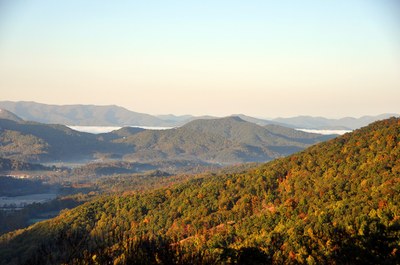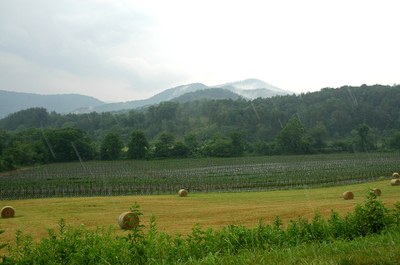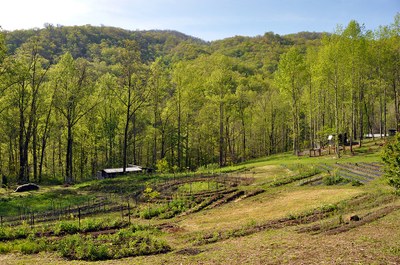Future of America's Forest and Rangelands 2010
USDA Forest Service
This summary is taken from text in the published assessment document referenced below.
Purpose
The 2010 Resources Planning Act (RPA) Assessment summarizes findings about the status, trends, and projected future of forests, rangelands, wildlife and fish, biodiversity, water, outdoor recreation, wilderness, and urban forests, as well as the effects of climate change upon these resources. The outlook for U.S. resources is largely influenced by a set of scenarios that have varying assumptions about global population and economic growth, global wood energy consumption, U.S. population and economic growth, land use change, and global climate change from 2010 to 2060. Four key themes from the findings are (1) land development will continue to threaten the integrity of natural ecosystems, (2) climate change will alter natural ecosystems and affect their ability to provide goods and services, (3) competition for goods and services from natural ecosystems will increase, and (4) geographic variation in resource responses to drivers of change will require regional and local strategies to address resource management issues. The results from this report will be useful to resource managers and policymakers as they develop strategies to sustain natural resources. The 2010 Resources Planning Act (RPA) Assessment is the fifth report prepared in response to the mandate in the 1974 Forest and Rangeland Renewable Resources Planning Act (Public Law 93–378, 88 Stat 475, as amended).
 Key Themes
Key Themes
Land development will continue to threaten the integrity of natural ecosystems.
Urban and developed land area is projected to increase across RPA scenarios between 41 and 77 percent by 2060. Although urban and developed land area remains a relatively small percentage of the U.S. land base, this expansion occurs at the expense of forest and rangelands. Forest land area is affected the most: forest losses are projected to range from 16 to 34 mil- lion acres in the conterminous United States. The South Region is expected to have the greatest loss of forest, ranging from 9 to 21 million acres, roughly 4 to 8 percent of the South’s 2007 forest land base.
The loss of forest land contributes to reduced growth in total forest inventory, reduced forest carbon stocks, and reduced tree canopy cover. Forest inventory volumes are expected to peak between 2020 and 2030, followed by a decline in volume to 2060. Only in one RPA scenario is inventory volume in 2060 less than in 2010, however. Carbon stocks are also projected to decrease across all RPA scenarios as a result of declining forest land area and changes in carbon stored per acre. The result is that forest land becomes an emissions source in future decades, the tipping point varying by the particular dynamics of land use change and timber harvest levels in each RPA scenario.
Although the loss of acres is important, low-density development may pose a greater threat to the integrity of remaining forest and rangelands through the effects of fragmentation. The expansion of housing in the wildland-urban interface and housing development around public lands fragment natural land covers and often lead to additional development. Habitat loss and degradation are major causes of species endangerment.
Climate change will alter natural ecosystems and affect their ability to provide goods and services.
Changes in temperature and precipitation generally had limited effects on the distribution of forest types and forest inventory during the RPA projection period, but those effects were more noticeable in the Western United States. At least in the immediate future, climate change is not posing a risk to having sufficient inventory to sustain forest products production. The risk to providing other forest ecosystem services is not known, however, nor is the potential effect of increasing occurrences of extreme events.
Climate change is projected to have substantial effects on water demand and supply. The primary effects of climate change on water demand are increases in agricultural irrigation and landscape watering in response to rising plant water needs. Across a range of RPA scenario-climate combinations, water withdrawal would increase from 2 to 42 percent from 2005 to 2060. The result of the combination of increasing water demand and declining water yields is an increase in vulnerability of the U.S. water supply to shortage, especially in the larger Southwest and Great Plains.
Change in terrestrial wildlife habitats will affect both the current habitat of wildlife species and their ability to migrate if habitats change. A comparison of areas of future stress to areas of current stress associated with the distribution of at-risk species and intense land uses indicated that the location of high current stressors tends not to overlap well with the location of high future stress associated with climate change. This lack of overlap potentially complicates the efforts of managers to prioritize wildlife conservation actions.
Climate variables only slightly affected outdoor recreation participation, with results indicating slight increases or decreases in participation rates and days of participation that varied across outdoor recreation activities. The exceptions were snowmobiling and undeveloped skiing (cross-country skiing and snowshoeing), for which climate effects resulted in substantial declines. The effects of climate change on the recreation environment are also expected to affect future outdoor recreation opportunities.
 Competition for goods and services from natural ecosystems will increase.
Competition for goods and services from natural ecosystems will increase.
Increasing water demands are likely to increase competition between water uses. The water projections indicate that the United States is on a pathway to unsustainable levels of water use in several regions across a range of RPA scenarios. Increased water use efficiencies, water demand reductions, increased trading or sale of water rights, and higher pricing for water consumed are possible mechanisms that could help to bring water supplies into balance with future water demands. Future water use levels depend most importantly on uses in the agriculture sector because irrigation requirements are highly sensitive to changing precipitation and temperature patterns. The current outlook indicates that demand pressures will increase, continuing or increasing current groundwater mining and further depleting streamflows, especially in drier areas of the United States. These pressures, in combination with development effects on water quality, raise concerns about the health and relative abundance of aquatic species in the future.
Species associated with aquatic habitats have higher proportions of at-risk species than other species groups. The condition of aquatic systems varies across the United States. Nationwide, more than one-half of monitored lakes were ranked in good condition, but only 28 percent of wadeable streams were ranked in good condition. Imperiled aquatic species tend to occur in areas with high population density, and many of those areas are projected to have increased population and development in the future. Maintaining or improving water quality and streamflows is likely to be challenging, especially in the face of increasing development pressure and water demands.
The availability of suitable land may constrain growing recreation demand. A stable public land base, a declining private natural land base, and increasing numbers of outdoor recreation participants are expected to result in increased conflicts among recreationists and declines in the quality and number of per-person recreation opportunities. The ability of recreation resources to absorb additional demand varies widely across the United States. The limited amount of public land in the East, where most forest land is privately owned, will likely be under greater stress from additional demand than public lands in the West. Pressures are likely to be greatest on public lands near large and growing population centers.
Timber resources are projected to be abundant enough to meet demands, especially if we continue to see efficiency gains in harvesting and conversion technology. Only the RPA scenario with the highest increase in wood biomass use for energy is expected to lead to potential competition for land resources with other uses, particularly with agriculture. The high harvest levels to meet these demands may create conflict with other forest uses. For example, the projected expansion of planted pine in the South Region to meet those biomass energy demands would displace natural pine, which may be undesirable from a biodiversity perspective.
Geographic variation in resource responses to drivers of change will require regional and local strategies to address resource management issues.
Projected population growth rates—and associated urban and suburban development patterns—vary across the United States. Areas with high population growth rates will see large expansions of urban areas, unless local and regional master plans are in place to manage the growth effects. Trees in urban areas—the urban forest—deliver a variety of ecosystem services. Retaining and managing trees in newly developed urban areas will be increasingly important in the future to continue receiving ecosystem services that are critical to urban quality of life. Low-density development patterns are more difficult to predict but are more likely to occur in rural areas where population continues to grow than in areas where population declines are projected.
The projected changes in vulnerability of the U.S. water supply vary geographically. Decreases in water yield (that in turn affects water supply) have a greater effect on future vulnerability than the effect of increases in water demand in about half of the assessment subregions (ASRs) where vulnerability is projected to increase. In some ASRs, the combined effect of changes in water yield and demand lead to untenable levels of vulnerability, suggesting that adaptation to water shortage there will be essential.
Imperiled aquatic species are concentrated in the Eastern and Southwestern United States. Where increased risks of water shortages are projected, threats to aquatic species are likely to increase. Conflicts about water uses, maintenance of instream flows, eroding water quality, and prices for water and water rights are all likely to increase in the future, exacerbating the threats to these species. Water policymakers and water rights owners are likely to face more tensions among water uses and pressures to change or adapt existing policies to better reflect shifting water use values.
 Looking Forward
Looking Forward
The United States has abundant natural resources. A growing population is projected to lead both to increased demands for a wide array of goods and ecosystem services from forests and rangelands and to shifts in land uses as public values for certain goods and services change. Woody biomass production to promote domestic energy security is a prime example. The outlook shown in this report is based on a continuation of current natural resource management policies in the face of projected changes in demographic and economic conditions and social values. The results highlight a number of areas in which pressures may emerge on policymakers to change current policies or develop new policy approaches. The negative effects on the environment, economy, and society portrayed by the scenarios in this RPA Assessment are not foregone conclusions. They can be avoided by timely actions from policymakers and land managers. This RPA Assessment lays the scientific foundation for taking action and dealing with the issues before their full effect is felt.
Preferred citation
US Department of Agriculture, Forest Service. 2012. Future of America’s Forest and Rangelands: Forest Service 2010 Resources Planning Act Assessment. Gen. Tech. Rep. WO-87. Washington, DC. 198 p.

























